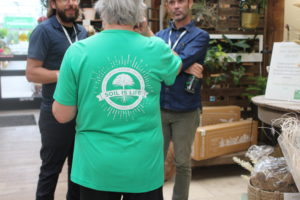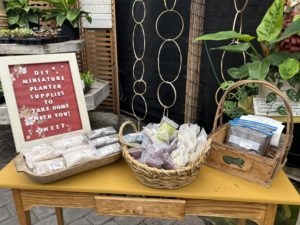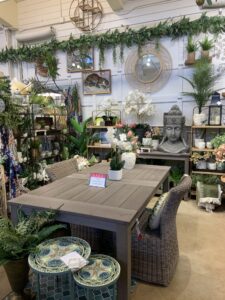Successful Sales
What is the next big area of garden retailing that, when improved, will increase profit?
You meet all of the discounted early-order deadlines. All of your available space, and then some, is full of product as often as possible. You have already made significant strides into improving efficiencies. You may have even taken in all of the marketing and advertising gains. You’ve “done it all,” and now the laws of diminishing returns are stifling every additional move you make.
What about sales? Have you considered that maybe the solution to your shrinking profits is not to save more money but to make more money? Sounds too simple to be true, but it is — and not by adding more sales people or using gimmicks. An “investment” in your sales approach could yield more profit dollars than you could imagine.
How Can Sales Help?
All successful companies have professional people whose sole function is to work closely with customers, to provide solutions, nurture the relationship, anticipate problems and, yes, capture new opportunities. These people are salespeople, and they are just as important to a small- to mid-sized garden center as they are to a Coke or a Toyota.
Through giving presentations on sales and studying the sales process, we have discovered six essential steps in all good sales transactions. Perhaps you simply need to add one of the steps to an existing method; perhaps you need a whole new system; or perhaps you just need to be reminded about the sales principles you already know. Regardless, these six steps can help.
Step 1: Planning to Succeed
Do you ever get caught unprepared? Are you ready to address customer issues such as, “What do you have that’s new and interesting?” “I can’t seem to keep anything alive.” “Can you match your competitor’s price?”
Planning for these questions and being prepared can mean the difference between increasing profits or watching margins erode. Planning means you have prepared to listen to questions and provide the best possible answer.
Before interacting with customers, you should do some planning exercises to fully understand your company’s strengths and weaknesses. If you are not prepared to talk about, or present, the following characteristics of your business, then it’s very difficult to achieve recognition for the value you provide. Be prepared to discuss:
* what differentiates your company from your strongest competitors;
* how your products are better;
* how your product provides a better value to the consumer;
* how certain products can be enhanced by other products; and
* the services you provide (delivery, installation, gift wrapping, etc.).
Step 2: Relationship Development
At the garden center, most purchases are based on Á trust — usually trust in the store — which is based on relationships. Because of this, relationships are the foundation of the sales process.
It is important to note that the relationships you have with your customers are usually in direct proportion to the size of buying commitment you will receive from them. If you have a small or casual relationship, then you can usually only ask for a small commitment. However, if the relationships are strong, the purchase you can ask for will be proportionately larger.
So how do we begin to build customer relationships that will develop into mutually beneficial arrangements? The answer lies in understanding the other person. Customers will buy your product not because they understand it, but because they feel you have a good understanding of them and what they need.
The best way to achieve this understanding is through asking questions that will give the needed perspective. Questioning will allow you to get to know your customer in ways that will help you determine which of your products best suits their needs. Asking questions and truly listening to the answers is how you will sell yourself to them.
Begin at a personal level with basics that help you get to know the client.
* What kind of garden do they want?
* How much time do they want to garden each week?
* What are some of their likes and dislikes?
* How many people are in their household?
* Are there children in the household?
These types of questions will help you begin to gain a better understanding of who your customers are and what forces motivate them, building rapport and moving your relationship forward.
Step 3: Asking Good Questions
As soon as you establish a relationship, you can consider a plan to differentiate your company from your competitors’, giving you the opportunity to ask for the price you need to cover your costs and to receive a fair profit margin.
You are now at a critical part of the selling process: asking good questions. The strength of good questions lies with your ability to listen, both before and after the question is asked. You have to listen to the customer to know what questions to ask, then you have to listen to their response to know what follow-up questions to ask.
Your objective is to uncover important and useful information that will help you make the sale, increase the sale and form the basis for follow-up sales. So you must ask questions in a way that encourages your customer to talk at length. Avoid asking questions that only require one-word responses.
It is essential that you plan your questions in advance. The first Á part of this planning is to identify the features and benefits of your company/product. You must have a full understanding of what you offer compared to your competitors. An example of your assessment may be:
* We remain on the cutting edge of gardening trends and stock the newest varieties.
* Our product quality and staff knowledge are second to none.
* We offer products to fulfill all of your gardening and outdoor living needs.
The benefits of your program will steer the line of questions you plan to ask. For instance, you would not ask how important it is to have a high percentage of new plant varieties if your mix includes few new items. Instead, you might ask about the importance of having the latest color trends, since you already have this aspect in your mix.
Asking the right questions will uncover problems for you to solve or opportunities to be captured. You will be asking questions such as, “What kind of light do you get in your yard?” and “What are your favorite colors?” You will probably not be able to ask every question needed to build a perfect garden, but you can address certain major issues and build on this foundation during later visits.
Step 4: Uncovering Real Needs
You are now at a point where it is enticing to start suggesting purchases based on the strong benefits that you have developed. Resist the urge! Presenting products too early may actually harm the forward progress of the sale.
For example, let’s say you are excited about your new water gardening department. You present a particular pond package to a customer looking to revamp her patio area. She states that she doesn’t have enough space or budget for a large pond and asks to look at less expensive, smaller projects. Any chance for top margins has now been eliminated.
It is important to have your customer specifically talk about their needs. This creates a clear understanding between you and the customer and allows you to reference these stated needs when you present your products. You can also put a spotlight on the customer’s needs by getting them to talk about the disadvantages of not having the product you offer. Let’s look again at the above dead-end example.
You added a water gardening department because there was substantial customer request, and you have stocked it effectively with projects of all scales and lots of different products. Through questioning about the customer’s space, you learn that she has a small patio space that already has a lush, tropical theme. A focal point is what she lacks. Now that you know her needs, you can suggest a specific, highly decorative wall-mounted fountain that drains into an in-ground, tiled water garden stocked with koi and water lilies — a premium margin sale.
Once you have identified the customer’s needs, you simply have to link your product or service to those needs by acknowledging what you heard them tell you during questioning. The easiest way to link what your customer has told you to your presentation is to acknowledge what you heard. You might say, “you told me that you needed a focal point for your patio.” Other segues might be, “you mentioned that . . .” or “you told me you were interested in . . .” There are many statements that can also be used to acknowledge that you understood what your customer expressed and are trying to solve their needs. You should feel free to use any statement you think accomplishes the goal.
This act of linking what your customer told you to points in your presentation is a very powerful sales technique. It immediately tells the customer that you listened, and you understood what they said. It shows sincerity on your part to sell not just what you want or have available, but rather, what the customer needs.
Another critical part of product presentation is the need to present your product or service in terms of features and benefits. Features and benefits must always be stated as an inseparable couple. One cannot exist without the other. State only a feature, and your customer may not understand exactly what your product can do for them. Stating only a benefit, while perhaps a little better, still leaves some customers guessing about how your product can achieve that benefit.
Features and benefits are quite different, and each must be understood in order to make an effective product presentation. Features simply make a statement about a characteristic of your product (e.g., all of my company’s 4-inch geraniums come with care instructions.), while a benefit describes what this characteristic will do for your customer (e.g., care instructions will help you grow larger, healthier geraniums).
This approach to product presentation will always be more effective than one that only focuses on features and has no relevance to a need specifically stated by the customer; however, features and benefits will best be referenced if they are thought out in advance of customer contact. The result will make the extra effort worthwhile.
Step 5: Achieving the Commitment
In the selling process, there are subtle signals that you have addressed the customer’s needs and they are ready to purchase. There is some danger to finalizing the sale if you miss these signals. The “buying signal” can sound something like:
* “This project looks like it will work well at my house.”
* “How much would this design cost?”
* “How long would it take to finish a project like this?”
When you hear an indicator that sounds like this, it’s important to conclude the sale. You can easily jeopardize your progress and blow all of your hard work if you miss the opportunity to finalize the sale.
The sequence outlined above is not only designed to get you the sale but to get the sale at the margin you require to remain profitable. Having followed the proper sequence, you are in a much better position to ask for this price than you would be without, for example, having tied your products and services to the customer’s needs. The sequence of steps is very important in allowing you to establish the value of the program you offer, before discussing price. If pricing is forced into earlier discussions, it will become the focus, without you having had the ability to present the full range of benefits your products or services offer, and you will not recover payment for these services. The value of what you have to offer must be established before the price, or your products are essentially reduced to a commodity.
Since there is almost always a negotiation period in the sales process, you should prepare for it and be ready to respond accordingly. You can ask for something in return: Instead of cutting out the flagstone walkway to save money, suggest another paving material; instead of leaving more grass area to maximize the view, suggest some low-growing plants or groundcovers. You can also present your limitations on the request and invite ideas on alternatives that work for both of you.
Step 6: Review and Planning
Immediately after the sale, you should review the events that led to the order. By replaying these events you will be in a much better position to repeat those steps that were the most critical in the success with the next customer you approach.
* Did I clearly outline the benefits, not just the features, of my products/services?
* Did I build a good “relationship” when working with the customer?
* Was I prepared to ask the best questions and get the customer talking about what is important to her?
* Did I uncover enough areas of need that can be addressed with my products and services?
* Was I fully prepared to negotiate the details of the sale when I received the order?
* What should I change the next time I am presenting my company and products/services?
A review of the process, addressing these types of questions, will likely prepare you more for the next visit with this customer and for future customers. If you answered “no” to any of the first five questions above, make it a point to get those answered for your next customer visit.
As business owners or managers, chances are, you deal with many sales people every day. Think about that person who does the best job for you; what skills and attributes do they present that are an asset? It’s not just price, but the overall value that cause people to buy, and the overall value is their experience.
Editor’s Note: This article has been adapted from an eight-part series by the same title that ran in sister publication GPN. To read the series in its entirety, go to www.gpnmag.com.

















 Videos
Videos





